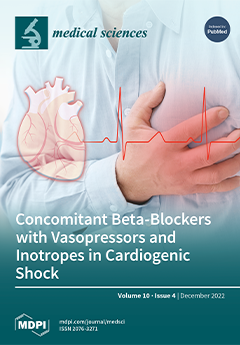Open AccessArticle
Population Risk Factors for Severe Disease and Mortality in COVID-19 in the United States during the Pre-Vaccine Era: A Retrospective Cohort Study of National Inpatient Sample
by
Kavin Raj, Karthik Yeruva, Keerthana Jyotheeswara Pillai, Preetham Kumar, Ankit Agrawal, Sanya Chandna, Akhilesh Khuttan, Shalini Tripathi, Ramya Akella, Thulasi Ram Gudi, Abi Watts, Christian C Toquica Gahona, Umesh Bhagat, Surya Kiran Aedma, Ayesha Tamkinat Jalal, Shyam Ganti, Padmini Varadarajan and Ramdas G Pai
Cited by 15 | Viewed by 4323
Abstract
Background-Previous studies on coronavirus disease 2019 (COVID-19) were limited to specific geographical locations and small sample sizes. Therefore, we used the National Inpatient Sample (NIS) 2020 database to determine the risk factors for severe outcomes and mortality in COVID-19. Methods-We included adult patients
[...] Read more.
Background-Previous studies on coronavirus disease 2019 (COVID-19) were limited to specific geographical locations and small sample sizes. Therefore, we used the National Inpatient Sample (NIS) 2020 database to determine the risk factors for severe outcomes and mortality in COVID-19. Methods-We included adult patients with COVID-19. Univariate and multivariate logistic regression was performed to determine the predictors of severe outcomes and mortality in COVID-19. Results-1,608,980 (95% CI 1,570,803–1,647,156) hospitalizations with COVID-19 were included. Severe complications occurred in 78.3% of COVID-19 acute respiratory distress syndrome (ARDS) and 25% of COVID-19 pneumonia patients. The mortality rate for COVID-19 ARDS was 54% and for COVID-19 pneumonia was 16.6%. On multivariate analysis, age > 65 years, male sex, government insurance or no insurance, residence in low-income areas, non-white races, stroke, chronic kidney disease, heart failure, malnutrition, primary immunodeficiency, long-term steroid/immunomodulatory use, complicated diabetes mellitus, and liver disease were associated with COVID-19 related complications and mortality. Cardiac arrest, septic shock, and intubation had the highest odds of mortality. Conclusions-Socioeconomic disparities and medical comorbidities were significant determinants of mortality in the US in the pre-vaccine era. Therefore, aggressive vaccination of high-risk patients and healthcare policies to address socioeconomic disparities are necessary to reduce death rates in future pandemics.
Full article
►▼
Show Figures






